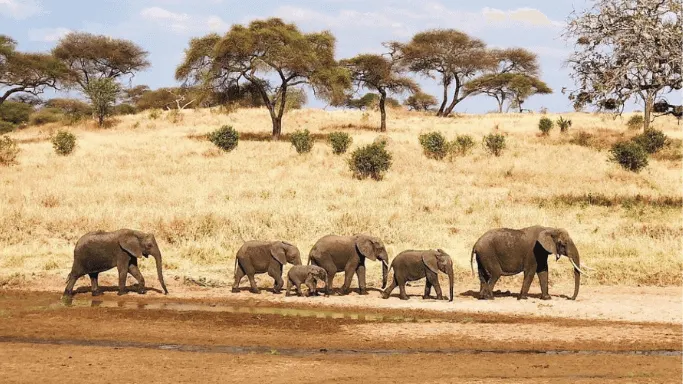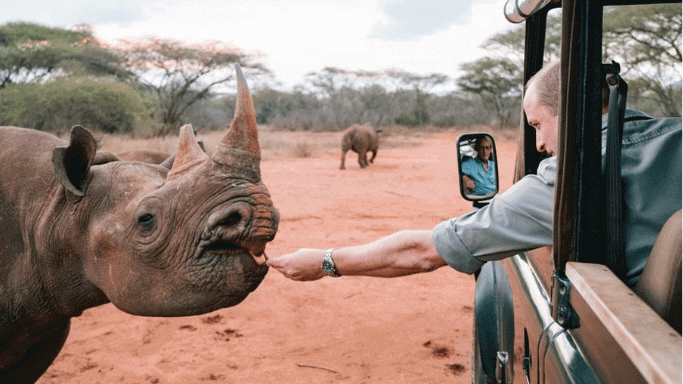Introduction to Lions in Tanzania

Lions are a powerful emblem of Africa’s wild landscapes, and nowhere is this truer than in Tanzania. The country is recognized globally as one of the most critical strongholds for lion populations. With its vast, varied ecosystems from grasslands to woodlands and volcanic highlands. Tanzania offers an ideal environment for lions to hunt, breed, and thrive.
Beyond their ecological role, lions contribute significantly to Tanzania’s economy through wildlife tourism. They are a flagship species, central to safari experiences and conservation messaging. Culturally, lions are deeply revered and symbolically represented in stories, language, and traditions throughout the country.
Are There Lions in Tanzania?
Yes, lions in Tanzania are native and widespread . They are indigenous to the African continent and remain one of the most iconic and important wildlife species in the country. Their historical and current presence is deeply rooted in both the natural ecosystems and the cultural fabric of Tanzanian society.
The word for lion in Swahili is “simba,” a term that captures the deep respect and significance attributed to the species. While many African countries have seen dramatic declines in lion populations, Tanzania remains a major refuge, with healthy numbers across several protected and semi-protected areas.
Tanzania Lion Population: How Many Lions Are There?
Estimates suggest that the population of Lions in Tanzania is around 15,000 — nearly half of the entire population on the African continent. However, the actual number can vary depending on the season, region, and survey method used. Techniques like spoor counts, camera traps, and call-in surveys have all been used to estimate lion abundance across different landscapes.

While Tanzania holds the largest population of lions globally, this does not mean they are without threats. Over the past 15 years, lion attacks on humans have risen, averaging more than 120 incidents annually. These attacks primarily occur in rural areas during harvest seasons when people guard their crops in temporary shelters, often placing them directly in the path of foraging lions.
The rise in human-lion conflict is linked to habitat encroachment and the loss of natural prey species, pushing lions closer to human settlements. Retaliatory killings in response to livestock losses and human fatalities further threaten lion numbers, despite their overall strength in Tanzania. Sustainable conservation efforts, education, and community-based programs remain critical for stabilizing and growing lion populations.
Lion in Tanzania Language and Culture
Lions hold a revered place in Tanzanian identity, not just in the wild, but also in language, art, and oral traditions. In Swahili, the national language, the word for lion is “simba” — a term that goes beyond just referring to an animal. It embodies qualities such as strength, bravery, leadership, and majesty. You’ll hear it used in everything from children’s names to sports teams, stories, and even political metaphors.
In many Tanzanian communities, lions appear in folklore as both protectors and symbols of danger. Traditional stories often portray the lion as a wise but fierce guardian of the savannah, teaching lessons about courage, survival, and respect for nature. Elders pass these stories down to younger generations, reinforcing the lion’s role as a cultural cornerstone.

Lions in Tanzania also appear frequently in local art forms — from carvings and paintings to textiles and jewelry. These depictions often blend realism with symbolic meaning, portraying the lion not just as a beast of the land but as a spiritual emblem of authority. In Maasai culture in particular, the lion has long been tied to rites of passage, where bravery against predators once marked the transition to warrior status.
Even proverbs highlight the lion’s stature. Sayings like “Simba hawezi kula majani” (A lion cannot eat grass) reflect ideas about purpose, nature, and identity. Through these expressions, the lion is celebrated not only as a predator, but as a metaphor for clarity, direction, and power.
Tanzania Lion Species and Physical Characteristics
| Feature | Description |
|---|---|
| Subspecies | Panthera leo leo (East African lion) |
| Adult Male Weight | 150–225 kg |
| Adult Female Weight | 110–165 kg |
| Bite Force | Approx. 650 psi |
| Gape Width | Up to 28 cm (11 inches) |
| Unique Traits | Whisker spot patterns (used for ID), mane variation, muscular build |
The lions Found in Tanzania belong to the subspecies Panthera leo leo, often referred to as the East African lion. This subspecies is known for its impressive size, muscular build, and tawny coat, which allows it to blend into the dry savannah and woodland environments typical of Tanzania. Adult males typically weigh between 150–225 kg, while females range from 110–165 kg. Body length and shoulder height also vary depending on the region and availability of food, with some individuals growing exceptionally large in prey-rich areas.
In terms of physical features, Tanzanian lions exhibit the broad head, strong jaw structure, and sharp carnassial teeth characteristic of the species. They possess a wide gape—up to 28 cm (11 inches)—allowing them to deliver bone-crushing bites with a force of around 650 psi. This makes them highly effective predators capable of taking down large prey like buffalo and zebra.
Lions in Tanzania also display variation in mane color and size, which can indicate age, genetic traits, and environmental conditions. Additionally, each lion has a unique whisker spot pattern, similar to a human fingerprint, which researchers use to identify individuals in the wild.

Fascinating Tanzania Lion Facts
- Lions in Tanzania are complex social animals living in structured groups called prides, which typically consist of related females, their cubs, and a small number of adult males. These prides maintain defined territories that can range from 20 to over 400 square kilometers depending on prey availability.
- A remarkable trait among The lions in Tanzania is their communication system. Lions communicate using a range of vocalizations, including roars that can be heard up to 8 kilometers away. These roars serve to assert dominance, warn intruders, and coordinate movements with pride members. Other methods of communication include scent marking, body language, and tactile interactions such as grooming.
- Tanzania also hosts some of Africa’s largest lion prides, sometimes reaching “super pride” status—groups exceeding 15 members and including multiple males. These super prides form under favorable conditions where prey is plentiful and territories are secure. Such groupings enhance hunting success and provide better protection for cubs, although they require frequent large kills to sustain the entire pride.
- The average gestation period for lions is around four months, and lionesses typically give birth to two to four cubs. Cubs are raised communally, with lionesses in the pride often nursing each other’s young. Despite their strength, lions face natural threats from disease, injury, and competition with other large carnivores, especially in ecosystems shared with hyenas and leopards.
Tree-Climbing Lions in Tanzania: Rarity or Behavior?
Tree-climbing lions in Tanzania are a rare but fascinating phenomenon, most often seen in Lake Manyara and parts of the Serengeti. Experts believe they climb trees to escape heat, avoid insects, or because of learned behavior. This unique trait makes them a major safari highlight.
While this behavior is not widespread across lion populations, certain prides in Tanzania appear to have adapted to their environments in surprising ways. For example, in the heat of the day, tree branches offer a breezy retreat with elevated visibility — giving lions a vantage point to monitor their surroundings. Insects like tsetse flies also tend to linger at ground level, making the trees an appealing escape. Some researchers suggest this habit is cultural: once adopted by a pride, younger lions learn it by observation. Though not guaranteed, a sighting of tree-climbing lions is a coveted experience that continues to draw curious travelers and wildlife photographers alike.

Lions Eating Humans in Tanzania: Myths vs. Reality
The notion of lions hunting humans has often been sensationalized, yet it reflects a very real challenge in parts of Tanzania. Human-lion conflict has escalated significantly over the past few decades, particularly in regions where human settlements are expanding into lion habitats. Analysis of district records and field surveys revealed that lions attack more than 120 people annually in Tanzania, with the highest number of incidents occurring in the southern parts of the country.

These attacks are most frequent during the harvest season—March to May—when people sleep in makeshift field shelters to guard crops from nocturnal pests. Lions are often drawn into these areas in pursuit of bushpigs, a preferred prey item, and encounter vulnerable humans in the process. Many attacks occur at night, when lions force their way into temporary huts and pull out sleeping individuals.
Retaliatory killings of lions following such events further complicate conservation efforts. While not all lion attacks are fatal, the fear they generate often leads to indiscriminate killing, reducing lion populations and increasing hostility toward conservation programs.
Despite the shocking nature of these attacks, it’s important to differentiate between isolated cases and widespread man-eating behavior. Research, indicates that lions resort to human predation primarily when their natural prey base has been depleted. This is often due to habitat fragmentation, illegal bushmeat hunting, and ecosystem degradation. Understanding these underlying factors is crucial to implementing targeted interventions, such as improved fencing, pig-control strategies, and safer agricultural practices.
Lion Attacks in Tanzania: A Conservation Perspective
Lion attacks in Tanzania are more than tragic news stories — they reveal a deeper conservation issue. When lions lose access to wild prey due to hunting, habitat loss, or farming, they may enter human settlements. Many attacks occur in rural districts, especially in the south, where people sleep in fields during harvest season.
The consequences go both ways: people are hurt, and lions are often killed in retaliation. Unfortunately, these killings can wipe out entire prides, including non-aggressive lions. This creates tension between local communities and conservationists.
To reduce conflict, solutions focus on education, better field shelters, controlling crop-raiding animals like bushpigs, and supporting local leaders in lion-monitoring programs. Protecting both people and lions requires understanding the causes — not fear-driven actions.
Walk with Lions in Tanzania: What to Know
The idea of walking with lions may seem exciting to travelers seeking up-close wildlife encounters, but in Tanzania, this experience is both rare and debated within conservation circles. While some private facilities promote lion interactions for photo opportunities, such experiences often raise questions about animal welfare, conservation ethics, and long-term impact.

For instance, some establishments market themselves as Wildlife sanctuaries or rescue centers but operate in a highly curated environment. Guests may dine or pose with a variety of animals — including lions, giraffes, zebras, and elands — in settings that prioritize visibility and entertainment. While some visitors describe these interactions as memorable, others have raised concerns about animal handling, enclosure sizes, and limited educational value.
In contrast, Tanzania’s best lion experiences come from witnessing them in the wild — behaving naturally in their native habitat. National parks such as Serengeti, Tarangire, Ruaha and Ngororo Crater offer guided game Safaris that are both respectful and rooted in conservation. These experiences not only support local economies but also contribute to efforts protecting the country’s status as the last stronghold for wild African lions.
If you’re passionate about wildlife, choosing responsible tourism ensures your visit leaves a positive mark. Supporting places where animals are observed not staged helps conserve Tanzania’s extraordinary natural heritage for generations to come.
Lions Sanctuary in Tanzania: What It Really Means

Following the fascination with walking alongside lions, some travelers also seek out sanctuaries that promise a more intimate look at these majestic creatures. But not all sanctuaries in Tanzania operate with the same intentions or integrity.
The term “sanctuary” often evokes images of protected spaces where animals are rehabilitated and allowed to live in peace. Yet in practice, some privately-run facilities use the label to attract tourism rather than prioritize welfare. In such places, lions may be confined to limited enclosures, prompted to interact with visitors, or displayed for curated photo sessions. While these encounters are often marketed as conservation efforts, the line between protection and performance can blur quickly.
In contrast, a strong example of ethical sanctuary practice in Tanzania is Mkomazi Sanctuary for rhinos in Tanzania . This government-partnered reserve focuses on the long-term rehabilitation and protection of endangered black rhinos — a model rooted in scientific management, education, and restricted access. The animals are not used for entertainment or interaction but are shielded from poaching and prepared for eventual reintroduction into the wild. This kind of sanctuary upholds the core mission of conservation: protection without exploitation.
Responsible sanctuaries like Mkomazi operate with transparency and often collaborate with researchers and conservationists. They maintain a clear boundary between human tourism and animal welfare, offering visitors the opportunity to learn without disrupting natural behavior.
So while “sanctuary” may be a commonly used term, its meaning varies widely. Supporting facilities that prioritize ethical standards, animal dignity, and long-term conservation goals ensures your visit has a truly positive impact, one that aligns with the values of protecting Tanzania’s iconic wildlife in the wild, where they belong.
Conservation Efforts and Challenges Facing Tanzanian Lions
Tanzania is home to one of the largest populations of wild lions in the world, but maintaining this status requires immense conservation efforts. Both government bodies and conservation NGOs are working tirelessly to protect these iconic animals — yet the path is far from easy.
Major Conservation Players

The Tanzania Wildlife Research Institute (TAWIRI), the Ngorongoro Conservation Area Authority, and international partners like Panthera and the Lion Recovery Fund lead critical efforts ranging from population monitoring to community education. These programs support scientific research, law enforcement training, and anti-poaching patrols to reduce illegal wildlife killings and habitat loss.
Despite these efforts, lions face mounting threats. Habitat fragmentation due to expanding agriculture, increasing human populations, and infrastructure development limits their roaming areas. Additionally, human-wildlife conflict — particularly retaliatory killings following livestock attacks — remains a significant challenge in pastoralist regions. Trophy hunting policies, though regulated, continue to stir ethical debates about their impact on lion populations.
Balancing Conservation and Livelihoods
In communities near lion habitats, economic vulnerability can lead to a lower tolerance for depredation. This makes education and community-based conservation initiatives essential. Programs that provide benefits for coexisting with lions — such as wildlife tourism revenue, compensation schemes, or improved livestock enclosures — are crucial in building long-term coexistence strategies.
Future of Lions in Tanzania: Can We Save Them?
Tanzania’s lion population stands at a crossroads — where hope, effort, and uncertainty all intersect. While challenges persist, there are signs of progress when it comes to preserving the country’s lion heritage. Adaptive strategies rooted in science, community cooperation, and forward-thinking policy are key to ensuring their survival.

Success stories such as localized predator-proof enclosures, improved livestock herding practices, and targeted awareness campaigns show that coexistence is achievable. Additionally, technology — including camera traps and GPS collaring — has revolutionized lion monitoring and behavior analysis, making it easier to detect threats and respond rapidly.
However, lasting success depends on scaling these efforts, securing sustainable funding, and addressing human pressures. As Tanzania’s population grows, conservation must integrate local needs with ecological imperatives — especially in buffer zones where human-wildlife interactions are most intense.
Why the World Needs Tanzania’s Lions
Lions are more than apex predators — they are ecological architects, cultural symbols, and ambassadors for African wilderness. Their presence signifies a healthy ecosystem where prey and predator exist in balance. Losing lions would not just impact biodiversity but unravel the ecological web of Tanzania’s landscapes.
For the world, protecting Tanzania’s lions is a shared responsibility. These lions represent one of Earth’s most iconic wildlife legacies, and their survival speaks volumes about our collective commitment to nature. Whether you’re a traveler, donor, or armchair wildlife enthusiast — your choices help shape their fate.
Support responsible tourism. Promote ethical conservation. And let Tanzania’s lions remind us all of what’s still wild, and still worth fighting for.



